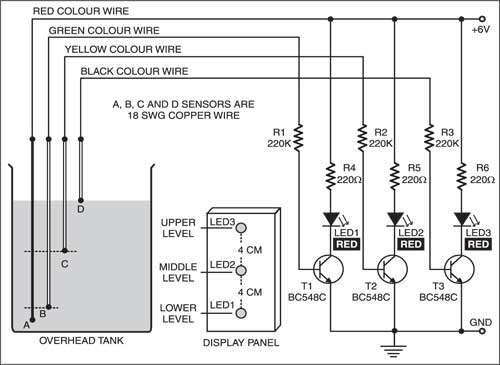 Here’s a simple water level indicator for overhead tanks that uses three LEDs (LED1, LED2, and LED3) to indicate minimum, middle, and maximum water levels in the tank.
Here’s a simple water level indicator for overhead tanks that uses three LEDs (LED1, LED2, and LED3) to indicate minimum, middle, and maximum water levels in the tank.
The sensor probes comprise A, B, C, and D, where A is the common probe and B, C, and D are meant for sensing the minimum, middle, and maximum levels, respectively. When water in the tank touches sensor wires A and B both, a small current passes from A to B through water and to the base of transistor T1 via resistor R1. As a result, transistor T1 conducts, causing LED1 to glow.
Similarly, when water touches sensor C, LED2 glows to indicate that the water has reached the middle level. Finally, when water touches sensor D, LED3 glows to indicate the maximum level of water. Thus all the three LEDs glow when the tank is full. At this stage, the motor should be switched off manually.
Water level indicator circuit

The circuit can be easily assembled on a general-purpose PCB and enclosed in a wooden box. The three LEDs should be mounted on the front panel of the box with a spacing of about 4 cm between them. Short lengths of four 18 SWG copper wires may be used for sensor probes.
For the common sensor A, a bare copper wire of 18 SWG should be used. For sensors B, C, and D three single-core PVC wires should be used, with their insulation removed to a length of one centimetre towards the ends. All the four wires may be tied around a 12.5mm dia. PVC tube with nylon thread at different heights, without touching each other (not shown in figure).
The sensor probes should be kept in the tank vertically and connected to the main circuit using four flexible PVC wires of different colours.
The circuit is powered by a battery eliminator or a 6V battery and kept near the motor switchboard. The current drawn by the circuit, when all the LEDs glow, is up to 50 mA, which is less than the current drawn by a 6V bed-lamp.
More interesting projects available here.










we need a kit, can u contact us at 8012533824
Hi,
Please go through the below link and see if it fullfill your need.
https://kitsnspares.com/user2/led_product_description.asp?id=106
I would like to have three circuits, Is it possible to have it at NCR
Does 18 swg copper wire may electrolysis in the water when use dc 6 volt ?
Use float switch in order to avoid electrolysis.
https://waterlevelcircuit.blogspot.com/2014/03/electrolysis-free-water-level.html
Superb… I like it
Thank you for your feedback.
can I put a buzzer in it ?
Yes, you can connect a buzzer across LED3 to give audio alert when the water tank is full.
How many volts required to turn on the process??what is the minimum resistance value for this process?? Why Bc 107 transistor is used here??
can i used it in industrial area?
How the water level can be indicated with a single led light with specific colour. Say green for full, yellow for medium and red for low water level. Only one bulb will display the level.
There is no hard-and-fast rule for the colour of LEDs used. You can use any colour combination as per your choice.
Can we use 9v instead of 6v here ?